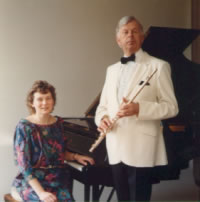| Christopher Hyde-Smith & Jane Dodd |
Buy this album CD: £10.00 +p&p |
| 01 | Fantaisie Op. 79 | Fauré | 5:03 |
| 02 | Madrigal | Aubert | 4:20 |
| 03 | Joueurs de Flûte Op. 27 - Pan | Roussel | 3:07 |
| 04 | Joueurs de Flûte Op. 27 - Tityre | Roussel | 1:05 |
| 05 | Joueurs de Flûte Op. 27 - Krishna | Roussel | 3:10 |
| 06 | Joueurs de Flûte Op. 27 - M. de la Péjaudie | Roussel | 1:34 |
| 07 | Morceau de Concours | Fauré | 2:49 |
| 08 | 14 Pieces pour Flûte et Piano Op. 157 | Kœchlin | 12:16 |
| 09 | Nocturne (de la-Croqueuse de Diamants) | Damase | 2:14 |
| 10 | Madrigal | Gaubert | 3:48 |
| 11 | Romance Op. 37 | Saint-Saëns | 5:43 |
| 12 | Sonata - Allegro malinconico | Poulenc | 4:15 |
| 13 | Sonata - Cantilena | Poulenc | 4:14 |
| 14 | Sonata - Presto giocoso | Poulenc | 3:28 |
Sleeve Notes
Since the clavecinistes of the 17th century French music has excelled in sensibilité, where style, delicacy and refinements take priority over passion. The existence therefore of a strong and abiding tradition of French music for that most delicate of wind instruments, the flute, is no surprise.
Treatises on Gabriel Fauré (1845-1924) speak of his reticent, restrained and subtle art. His gift was for beautiful melody supported by an occasionally unorthodox, telling harmony, as exhibited in both of his pieces recorded here. In the Fantaisie (1898) a haunting, melancholy E minor andantino is followed by a bright C major allegro with skittish first subject and cantabile second. A suitably burnished version of the andantino melody separates them, but is not recapitulated.
The existence of Morceau de Concours was unknown until rediscovered by an American musicologist in the 1970's. It was found amongst papers which contained treasures by other composers that the Paris Conservatoire had intended for the pulp mills. It is thought to have been written as a sight reading test but is of extraordinary beauty.
The "Madrigal" of Louis Aubert (1877-1968) probably composed in the 1890's is dedicated to the flautist and fellow composer, Philippe Gaubert (1879-1941) who later wrote a "Madrigal" of his own. The title of these two romantic melodies becomes less strange if we know that the madrigal can be traced back to Troubadour songs of a knight's love for a shepherdess.
Visits to the East both as a youth in the navy and later (1909) as an established composer brought Albert Roussel (1869-1937) into contact with Indian Music, widening his melodic and rhythmic scope. His use of non-European scales is relevant here. Tne god Pan is the first of his Joueurs de Flûte, (1924), each piece dedicated to a different contemporary exponent of the instrument. Several modes are employed, while the underlying two or three tonalities are coloured by others giving the music by turns amorous, sultry, mischievous and frightening (panic) character. The featherweight dancing melody of Joueur number two, the legendary shepherd Tityrus is delicacy indeed, its jollity utterly belying the sadness of its Phrygian mode. The Hindu god, Krishna uses a 7/8 metre and a scale with its semitones surrounding the keynote and 5th. Interestingly it is the common chords in the accompaniment - including the last - that disturb. Each serious Joueur is followed by a jollier. Monsieur de la Péjaudie played the flute in front of a mirror in the novel, La Pécheresse by Henri de Régnier. We can imagine his pursed lips and mobile eyebrows as he appreciates his own passionate rendering of a deliberately rather banal little dance tune.
Charles Kœchlin (1867-1950) most of whose large output in all forms and many styles has been neglected, believed firmly in the importance of a self-supporting melodic line. This permits the free and greatly varied accompaniments, contrapuntal and chordal, that he supplies to his 14 pièces, only three of which are more than a minute long. Tle delightfully fresh melodies are deceptively innocent, taking some surprise turns which are however never perverse. A few have titles; no.1 "Old Song" has a modal melody, that of no.7 "Fine Evening" arches broadly across the sky to immensely spacious open 5th-dominated chords, no.9 (untitled) has a vaguely Scots flavour, no.12 is "Spring Dance" and no.13 "Funeral March" with a sombre, dactylar melody. Tne last piece is almost Handelian, using the flute in a fanfare-like way.
Kœchlin might not have approved of Jean-Michel Damase's sleepy Nocturne, whose drooping eyelid melody of two alternating notes necessarily depends upon its viscous harmony, but so does Chopin's E minor prelude.
Camille Saint-Saëns (1835-1921) whose precocious and prodigious talents as composer, pianist and organist were matched by his industry (13 operas, 10 concertos, extensive tours etc.) is the earliest of the composers represented here. Between the two of- the-period melodies of his Romance (1874) things become unexpectedly not a little agitated, as has been known to happen in romances, e.g. that of Mozart's D minor concerto.
By the 1950's there was little left of the anti-romantic, anti-impressionist obtuseness, which characterised the music of Francis Poulenc (1899-1963) as a member of the "Les Six" group of composers in the 20's. The initial and rnain theme of the opening allegro malinconico of his Sonata for flute and piano (1957) is set in motion, pervaded and concluded by two versions of an engaging arpeggio 'diddle-diddle-dum', whose major-minor harmony at the end of the movement neatly sums up the strange, conflicting fast and melancholy mood. A sliding figure similarly characterises the middle theme of the movement's simple ABA form.
The central movement, entitled Cantilena consists mostly of an intensely beautiful, wide-ranging melody, at times almost Bach- like, at others essentially French. A Germanic element - perhaps Haydn via Offenbach, or is it the British Grenadiers or even Handel's Halleluja, possibly all three? - also steals into the final Presto giocoso, which lives up to its title. The first movement's 'diddle-diddle-dum' fits in happily, but the melancholy of its more dignified, sliding theme momentarily interrupts this headlong gallop.
Credits
Producer: Martin ComptonRecording: Colin Attwell
Notes: Roger North © 1989.
Cover: Il y'en a Toujours by Marcus Stone
Courtesy of The Tate Gallery
Location: St. John's Smith Square
Piano: SteinwayAll rights reserved. Unauthorised copying, hiring, lending, public
performance and broadcasting prohibited
Label
Claudio Records Limited
Colin Attwell (Director)
Studio 17, The Promenade
Peacehaven, East Sussex
England. BN10 8PU
Tel/Fax +44 (0) 1273 580250
Mobile: +44 (0) 7919086234
E-mail: info@ClaudioRecords.com
Web: www.ClaudioRecords.com
| Instruments: | Flute and Piano |
| Genre: | Classical |
| Format: | CD |
| Our Ref: | A0012 |
| MCPS: | CR3808-2 |
| Label: | Claudio Records Limited |
| Year: | 1989 |
| Origin: | UK |
Christopher Hyde-Smith & Jane Dodd
Christopher Hyde-Smith and Jane Dodd first performed together at the Stowe Summer School. Here they established an immediate musical rapport and were greatly encouraged by the enormous enthusiasm with which their concerts were received. A regular duo partnership was formed in 1984 following an invitation to play the complete works for flute and keyboard by Bach and Handel as part of the City of London's celebrations for the tercentenary of the births of these composers. Christopher and Jane are familiar from their numerous broadcasts which have included first performances and for their many concerts and masterclasses throughout the British Isles. They recently gave highly acclaimed recitals to capacity audiences at the Arundel and Chester festivals. They have also played in France and Austria. Future plans include broadcasting the complete works of the French composers 'Les Six', and recently rediscovered works of William Alwyn. One of their attractions is their very varied repertoire. In addition to being a pianist Jane has a magnificent double manual harpsichord which she can transport, as well as a portable harmonium and an electric keyboard if the venue dictates. Christopher has flutes in six different pitches, which can be used in one work, as well as demonstrating home-made, baroque and classical flutes. Christopher Hyde-Smith
Christopher Hyde-Smith is a professor of flute at the Royal College of Music, where he also studied. He was the founding chairman of the British Flute Society. He plays on a golden flute. Jane and Christopher were married in 1985 and have two daughters.
'Never in Munich has a flute player had such a success - and well deserved.' SUDDEUTSCHE ZEITUNG '...... he is among the few [flautists] who are in the finest category.' THE GRAMOPHONE
Jane Dodd
After winning numerous prizes at the Royal College of Music and gaining an honours degree at King'sCollege London, Jane Dodd has spent most of her musical life as an 'unashamed accompanist'. She was a prizewinner in competitions organised by Greater London Arts, Park Lane Group, The Incorporated Society of Musicians, The Worshipful Company of Musicians, and The Kirkman Concert Society. Her recital work has included performances at the Wigmore Hall, Purcell Room, Festival Hall, Albert Hail and St. John's Smith Square. Concert partners have included Jack Brymer, James Galway, Ifor James, Felicity Lott, Robert Tear, Hugh Bean and Douglas Cummings and she regularly partners oboist Andrew Knights and is a member of a piano trio. Jane has played for BBC Radio Education Programmes and has three times toured the USA. Work has also included accompanying the choir of St. Martin-in-the-Fieldsand playing as orchestral pianist in the BBC Symphony Orchestra. She is no stranger to masterclasses and has acted as official accompanist at the BBC TV 'Young Musician of the Year' competition. Recently she has been teacher and accompanist at the Purcell specialist music school and her work at summer schools takes her to Ramsgate International Summer School and a summer school in the Austrian Tyrol. Pieces have been dedicated to Jane by composers Dominic Muldowney and David McBride. "Jane Dodd's accompanying was exemplary.' SUNDAY TIMES "In Jane Dodd he has found a rare accompanist, outstanding indeed was the quality of artistry and skill." DAILY TELEGRAPH "Jane Dodd was an unfailing tower of strength throughout a taxing programme." YORKSHIRE POST |
Photographs
by Fritz Curzon |
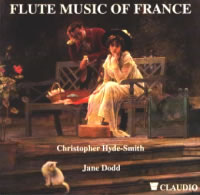 Since the clavecinistes of the 17th century French music has
excelled in sensibilite, where style, delicacy and refinements
take priority over passion. The existence therefore of a strong
and abiding tradition of French music for that most delicate
of wind instruments, the flute, is no surprise. This recording
includes many rarities.
Since the clavecinistes of the 17th century French music has
excelled in sensibilite, where style, delicacy and refinements
take priority over passion. The existence therefore of a strong
and abiding tradition of French music for that most delicate
of wind instruments, the flute, is no surprise. This recording
includes many rarities.
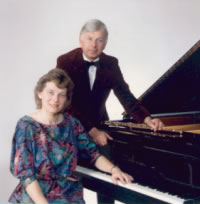
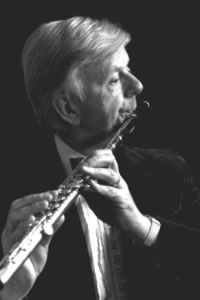 Christopher
Hyde-Smith's flute playing has been compared in the Guardian
to Sir Lawrence Olivier's acting in variety of expression, characterization
and style. He has played all over the British isles and at many
festivals including Aldeburgh, The Three Choirs, North Wales
and York. He has made many trips abroad appearing as soloist
in France, Germany, the Netherlands, Italy, Portugal, Scandinavia,
Spain and Switzerland as well as North and South America. He
has also visited Russia in an ensemble directed by Benjamin Britten.
Other distinguished musicians with whom he has performed include
Casals, Poulenc, Tortelier and Stravinsky. Christopher has played
the Cimarosa Concerto for two flutes with james Galway at the
Royal Festival Hall and as concerto soloist he has frequently
appeared with the London Mozart Players and also with the London
Symphony, Royal Philharmonic, Royal Liverpool Philharmonic, BBC
Concert, Scottish and Welsh Orchestras, Philornusica and Northern
Sinfonia. Many composers have written and dedicated works to
him, among them William Alwyn, Stephen Dodgson, Joseph Horowitz,
William Matthias, John Metcalf and Alan Rawsthorne.
Christopher
Hyde-Smith's flute playing has been compared in the Guardian
to Sir Lawrence Olivier's acting in variety of expression, characterization
and style. He has played all over the British isles and at many
festivals including Aldeburgh, The Three Choirs, North Wales
and York. He has made many trips abroad appearing as soloist
in France, Germany, the Netherlands, Italy, Portugal, Scandinavia,
Spain and Switzerland as well as North and South America. He
has also visited Russia in an ensemble directed by Benjamin Britten.
Other distinguished musicians with whom he has performed include
Casals, Poulenc, Tortelier and Stravinsky. Christopher has played
the Cimarosa Concerto for two flutes with james Galway at the
Royal Festival Hall and as concerto soloist he has frequently
appeared with the London Mozart Players and also with the London
Symphony, Royal Philharmonic, Royal Liverpool Philharmonic, BBC
Concert, Scottish and Welsh Orchestras, Philornusica and Northern
Sinfonia. Many composers have written and dedicated works to
him, among them William Alwyn, Stephen Dodgson, Joseph Horowitz,
William Matthias, John Metcalf and Alan Rawsthorne.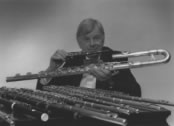 'Christopher
Hyde-Smith is an absolutely first rate flautist...' STEREO
REVIEW, USA
'Christopher
Hyde-Smith is an absolutely first rate flautist...' STEREO
REVIEW, USA